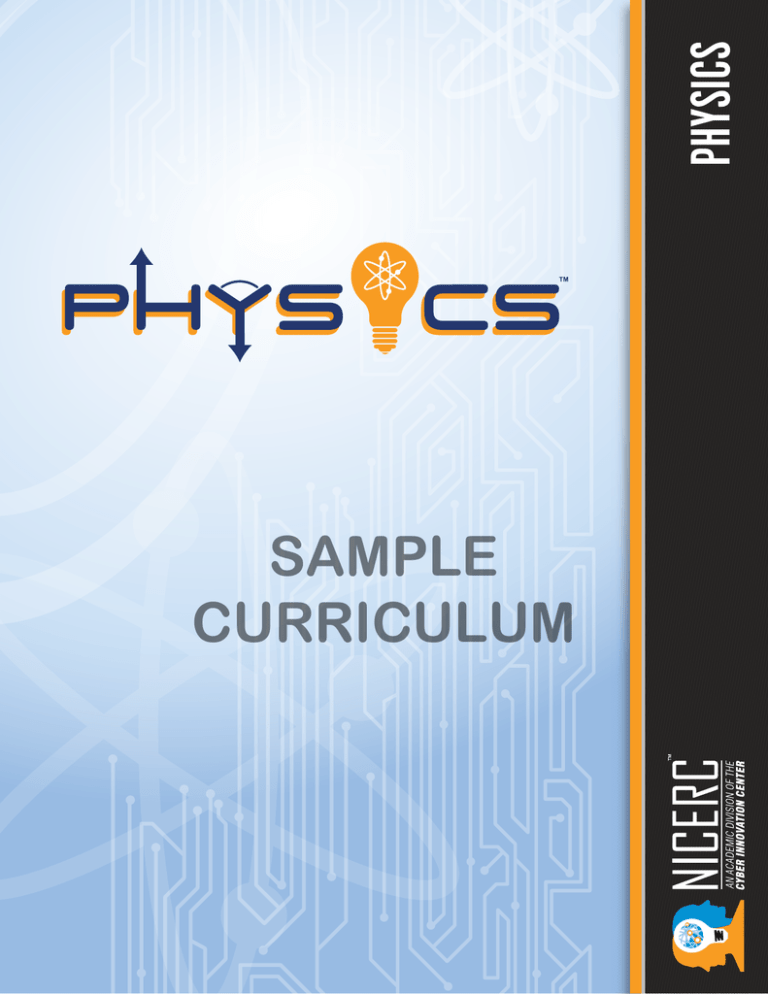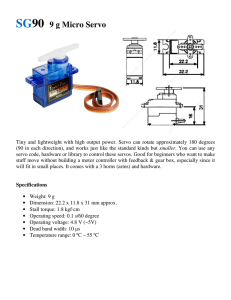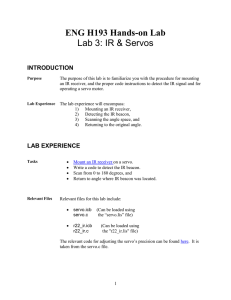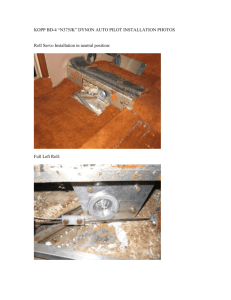
SAMPLE
CURRICULUM
Work and Mechanics: 4 Energy Conversion - 04 Servo Data Collection AP
www.NICERC.org
LESSON OBJECTIVES
Materials
I. Learning Outcomes
• TLW acquire the data needed to evaluate the efficiency of an electric gear motor
lifting various weights.
From last class:
- Teams of 2 students
- Multimeters (2 per team)
II. Learning Summary
• Review fundamentals from the last class to provide a context for the experiment.
(Provide the big picture.)
- Wall power supplies for
Boe-Bots
- Grooved wheels to serve
as pulleys
• The objective for the class is to acquire all of the data required to characterize the
efficiency of a servo motor. Move through the initial discussion quickly to allow as
much time as possible for actual data collection.
- Fishing line
• Acquire the data and fill in the data sheet.
- Computers with PBASIC
• Groups can take data for more weights if they finish early. Groups that do not finish
can continue later (two class periods from now).
New for this class:
- Data sheets
- 4 weights for each team;
0.1 to 0.8 pound weighted
items
AP EXAM CONCEPTS
- Digital balance/scale; 1-2
for class
As identified by © 2014 The College Board.
- Stopwatch; 1 per team
Objective Covered (1 and 2): The Interactions of an Object with Other Objects can be
Described by Forces
- Ruler or tape measure
•
Essential Knowledge 4.B.1: The change in linear momentum for a constant‐mass
system is the product of the mass of the system and the change in velocity of the center
of mass.
•
Essential Knowledge 4.B.2: The change in linear momentum of the system is given
by the product of the average force on that system and the time interval during which
the force is exerted.
This material is based upon work
supported by the U.S. Department
of Homeland Security under Grant
Award Number, 2013-PD-127000001, Modification #2.
1
Copyright © 2016 Cyber Innovation Center
All Rights Reserved. Not for Distribution.
Work and Mechanics: 4 Energy Conversion - 04 Servo Data Collection AP
www.NICERC.org
SERVO DATA COLLECTION
Review of Fundamentals
• Work can be used to lift weights.
• The potential energy change of a lifted weight is proportional to the change in height.
• Energy cannot be created or destroyed; it can only change forms.
1. Work to heat (dragging a weight across a blanket)
2. Work to potential energy (lifting a weight)
3. Electricity to work (servo motor)
• We can determine the amount of energy entering a servo as electricity and the amount of useful energy released as
potential energy change of weight.
Class Project - Servo Efficiency
Part II ‐ Data Collection:
Today you will perform the necessary measurements to quantify the electrical
energy input and the mechanical work output of a servo as it operates under four
different loads (weights).
The setup looks like this:
The measurements we need to take are shown in the datasheet provided below.
Weight Name
Weight (lbs)
Pulling Height
h
(in)
Pulling Time
t
(s)
Voltage
V
(V)
Current
I
(A)
2
Copyright © 2016 Cyber Innovation Center
All Rights Reserved. Not for Distribution.
www.NICERC.org
Work and Mechanics: 4 Energy Conversion - 04 Servo Data Collection AP
Teacher Notes:
The voltage and current
readings will fluctuate
slightly. Just record a
typical value (near the
middle of the range). Use
weights ranging from about
0.1 pound to 0.8 pounds,
with relatively even spacing
between weights. It is
hard to juggle everything
at once. Students will
probably need to rerun
experiments several times
to have good data.
Weight
Name
Weight (lbs)
Pulling
Height
h
(in)
Pulling
Time
t
(s)
Voltage
V
(V)
Current
I
(A)
keys
0.1495
25
3.8
4.86
0.13
cell phone
0.3805
25
5.4
4.73
0.18
plastic
container
0.6
27
6.2
4.52
0.22
hammer
0.793
18
5.7
4.35
0.26
3
Copyright © 2016 Cyber Innovation Center
All Rights Reserved. Not for Distribution.
Work and Mechanics: 4 Energy Conversion - 23 Servo Data Collection AP
www.NICERC.org
NAME:
1. Titan is the largest of Saturn’s moons and has a dense atmosphere which would allow a helium-filled blimp to easily
float above its surface. NASA has proposed “The Aerover Blimp” as a vehicle for collecting atmospheric data at different
altitudes as well as data from landings on Titan’s liquid hydrocarbon lakes or rocky surface. Titan has a diameter that
is almost double that of our moon and about 40% that of earth. Because of the smaller mass of the planet, things on
Titan only weigh 14% of what they weigh on earth. If the Aerover Blimp weighs 220 pounds on earth, then estimate
the potential energy of the blimp relative to the surface of Titan when the blimp is at an altitude of 1 kilometers (1,000
meters). Please provide your answer in joules.
1
Copyright © 2015 Cyber Innovation Center
All Rights Reserved. Not for Distribution.
Work and Mechanics: 4 Energy Conversion - 23 Servo Data Collection AP
www.NICERC.org
2. Assume the Aerover Blimp is propelled by a 4-bladed propeller driven by an electric motor.
a. If 105 watts of electrical power is used for propulsion, then how much current will the electric motor draw if it
operates at 12 volts?
b. How much energy would be consumed by the electric motor in a 24 hour period? Remember that energy (joules) is
the product of power (watts) and time (seconds).
2
Copyright © 2015 Cyber Innovation Center
All Rights Reserved. Not for Distribution.
Work and Mechanics: 4 Energy Conversion - 23 Servo Data Collection AP
www.NICERC.org
HOMEWORK SOLUTIONS
1. Titan is the largest of Saturn’s moons and has a dense atmosphere which would allow a helium-filled blimp to easily
float above its surface. NASA has proposed “The Aerover Blimp” as a vehicle for collecting atmospheric data at different
altitudes as well as data from landings on Titan’s liquid hydrocarbon lakes or rocky surface. Titan has a diameter that
is almost double that of our moon and about 40% that of earth. Because of the smaller mass of the planet, things on
Titan only weigh 14% of what they weigh on earth. If the Aerover Blimp weighs 220 pounds on earth, then estimate
the potential energy of the blimp relative to the surface of Titan when the blimp is at an altitude of 1 kilometers (1,000
meters). Please provide your answer in joules.
mass= 99.8kg
h = 1, 000m
m
m
a= 0.14 ⋅ 9.81 2= 1.37 2
s
s
U p1 = wt ⋅ h = (1.37 ⋅105 ) J
weight ( wt=
) mass ⋅ a= 137.1N
2. Assume the Aerover Blimp is propelled by a 4-bladed propeller driven by an electric motor.
a. If 105 watts of electrical power is used for propulsion, then how much current will the electric motor draw if it
operates at 12 volts?
b. How much energy would be consumed by the electric motor in a 24 hour period? Remember that energy (joules) is
the product of power (watts) and time (seconds).
Part a: P= 105 watts
voltage = 12 V
Part b: t = 24 hr = 86400 seconds
U electric
P
= 8.75 amps
V
= P ⋅ t = ( 9.072 ⋅106 ) J
=
I
3
Copyright © 2015 Cyber Innovation Center
All Rights Reserved. Not for Distribution.
Work and Mechanics: 4 Energy Conversion 06 Servo Efficiency Analysis
www.NICERC.org
LESSON OBJECTIVES
I. Learning Outcomes
•
TLW generate a spreadsheet requiring data input and computation.
•
TLW compute servo efficiency under various operating conditions.
•
TLW use spreadsheet software to create a properly formatted plot.
II. Learning Summary
• Review how efficiency is computed for an electric motor that lifts a weight.
• Enter the servo data collected earlier into a spreadsheet. Use this data to compute
the efficiency of the servo.
• Create a properly formatted plot of servo efficiency versus weight lifted. The plot
must have a title and axis labels with units.
This material is based upon work
supported by the U.S. Department
of Homeland Security under Grant
Award Number, 2013-PD-127000001, Modification #2.
1
Copyright © 2016 Cyber Innovation Center
All Rights Reserved. Not for Distribution.
Work and Mechanics: 4 Energy Conversion 06 Servo Efficiency Analysis
Teacher Notes:
www.NICERC.org
SERVO EFFICIENCY ANALYSIS
Review of Fundamentals
Efficiency is a measure of how successfully energy can be utilized to do a job. For the servo
the efficiency is:
η=
wt ⋅ ∆h
PE change of weight
⋅ 1000% =
⋅ 100%
V ⋅ I ⋅t
electrical energy consumed by servo
J
}
Wt = weight (N)
}
wt ⋅ ∆h
J
J energy out
=
= =
V ⋅ I ⋅t J ⋅ s J
energy in
s
J
s
W=
s
∆h = change in height of weight (m)
V
= voltage to servo (V)
I
= current drawn by servo (A)
t
= time the servo is operated (s)
Analysis of Servo Data
If students still need to
collect data, they can
do that during this class
period and complete the
analysis as homework.
Student groups should do the following:
1. Enter the data collected in the previous class into a spreadsheet which includes a title
and column titles with units.
2. Embed the equation above into the spreadsheet to calculate the efficiency for each
weight lifted.
3. Plot the efficiency as a function of the weight lifted.
2
Copyright © 2016 Cyber Innovation Center
All Rights Reserved. Not for Distribution.
Work and Mechanics: 4 Energy Conversion 06 Servo Efficiency Analysis
www.NICERC.org
Example Spreadsheet:
Weight
Name
Weight
(lbs)
Pulling
Height
h
(in)
Pulling
Time
t
(s)
Voltage
V
(V)
Current
I
(A)
PE
Change
(J)
Electrical Electrical System
Energy Efficiency
Power
(W)
(%)
(J)
keys
0.1495
25
3.8
4.86
0.13
0.42
0.63
2.40
17.6
cell phone
0.3805
25
5.4
4.73
0.18
1.07
0.85
4.60
23.4
plastic
container
0.6
27
6.2
4.52
0.22
1.83
0.99
6.17
29.7
hammer
0.793
18
5.7
4.35
0.26
1.61
1.13
6.45
25.0
a
b
c
d*e
d*e*c
d
e
a * 4.448 * b * 0.3048
g
f
Example Plot:
f
⋅100%
g
Servo Efficiency versus Weight Lifted
title
35.0
Servo Efficiency (%)
30.0
25.0
20.0
create a scatter plot
15.0
10.0
5.0
0.0
0
0.1
0.2
0.3
0.4
0.5
0.6
0.7
0.8
0.9
Weight Lifted (lbs)
axis label
units
3
Copyright © 2016 Cyber Innovation Center
All Rights Reserved. Not for Distribution.




